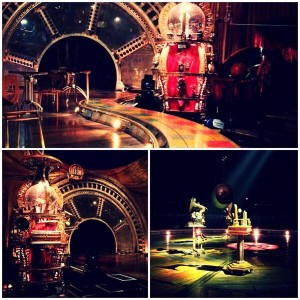 The set design of KURIOS – Cabinet of Curiosities puts the spectator in a well-defined place: the curio cabinet of a Seeker filled with unusual objects collected on his travels. Set in what could be called a retro-future, the scenic environment makes several references to the beginning of the industrial revolution during the 19th Century without being tied to that period. “It’s like Jules Verne meets Thomas Edison in an alternate reality, out of time,” explains Set Designer Stéphane Roy.
The set design of KURIOS – Cabinet of Curiosities puts the spectator in a well-defined place: the curio cabinet of a Seeker filled with unusual objects collected on his travels. Set in what could be called a retro-future, the scenic environment makes several references to the beginning of the industrial revolution during the 19th Century without being tied to that period. “It’s like Jules Verne meets Thomas Edison in an alternate reality, out of time,” explains Set Designer Stéphane Roy.
In this parallel reality, it is the steam engine and not the internal combustion engine that reigns supreme. The set evokes the start of the industrialization era, but as if science and technology had evolved differently and progress had taken on a more human dimension.
An alternate poetic reality
The performance space is dominated by two structures called “cabinets;” one explores the topic of sound and the other, the topic of electricity. Built by the Seeker using scraps and pieces collected over time, the two large towers also serve a “wave sensors” made from miscellaneous components such as gramophones, old typewriters, electrical bulbs and turbines. In actual fact, these objects were salvaged from junkyards then dismantled, amalgamated, given a patina and joined together using tubes and pipes.
The two cabinets are attached to the main arch – another wave sensor – that dominates the stage. The opening at the centre, at the back of the stage, evokes the mouth of a railroad tunnel through a mountain; it is mainly through this opening that artists move in and out of the spotlight and that equipment and props are taken on and off the stage.
The show is a tribute to imagination and curiosity. This makeshift mechanical world celebrates the coming together of pre-existing objects. “All these objects – the bugle, the typewriter – come with their own history and it is from their association that a new meaning emerges,” says Roy. “Further proof that the who is greater than the sum of its parts.”
The Mechanical Hand
A huge steampunk-inspired mechanical hand appears during the show either as a character or as a performance structure. Operated by two artists using a pedal and gear mechanism, the all-fiberglass hand is an automaton built from various parts that look like wood, metal, marble and iron. In the Set Designer’s mind, the Seeker built the hand with rare objects collected on his travels: a wooden finger found in Sienna during the Renaissance, a nail picked up in a Greek temple, and so on. The mechanical hand is a paragon of the DIY (do it yourself) ethos and evokes the richness and the materials from the era of the greatest scientific discoveries. It is on this hand that the contortion act and the “Hands Continent” scene unfold.
Autonomous structures
For greater emphasis on the performance, every act in the show is presented on an independent structure – a module or a promontory – integrated into the set design. The stage was lowered 35 cm and a bank was installed all around the stage (the bank is a 60-cm-wide raised walkway on which two rails are installed for transporting various props).
Presented on their separate, distinct structures, the acts in the show represent the curios that jump to life inside the Seeker’s workshop. During the Russian cradle duo act, for instance, a giant leather chest opens up to reveal, encased in sumptuous Moroccan cushions, two characters that look like mechanical dolls. Another example: the aerial straps artists perform on a gigantic “drop of mercury” made entirely of fiberglass and covered in silver leaf.
A “real” imitation wooden floor
Building the stage floor presented a real technical challenge. To create the impression of a real wooden floor, a 3D finish was produced. Silicone was poured onto century-old planks of wood to produce a mold into which varnish was poured. A total of 26 coats of paint and clear varnish were applied alternately to give the wood its rich finish.
Set Design Close-ups
- The mechanical hand weighs 340 kg and measures 4.6 m by 2.1 m.
- The train in the “Chaos Synchro” act extends out from Mr. Microcosmos’ costume over a distance of 19 m. The train’s structure is all aluminum and the outer shell is made out of a mostly vinyl canvas. Fiberglass mosquito screen was used for the windows.
- Standing 3.5-meters tall, the Seeker’s chair is decorated with recycled pieces of metal.
- The hot-air balloon used in the “Hands Continent” scene is made of fabric and has a built-in blower system. It serves as a projection screen 4.3 m in diameter. The gondola is made of metal and tulle.
- The turbine at the back of the stage behind which the musicians are installed is made of thermally molded plastic over a metal structure.
- The tarpaulin at the back of the stage is made of 680 m2 of fabric that was given a patina.
- The stage floor is composed of 160 independent panels.
{ SOURCE: Cirque du Soleil }